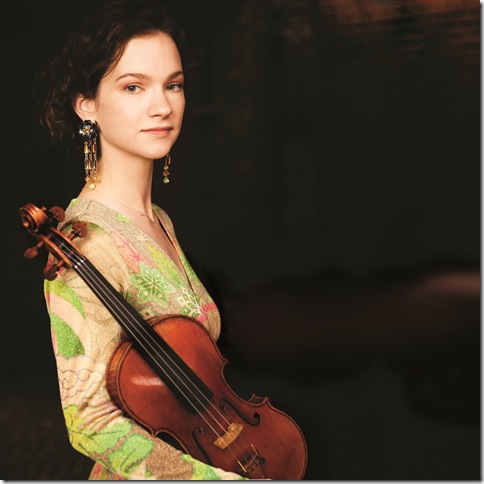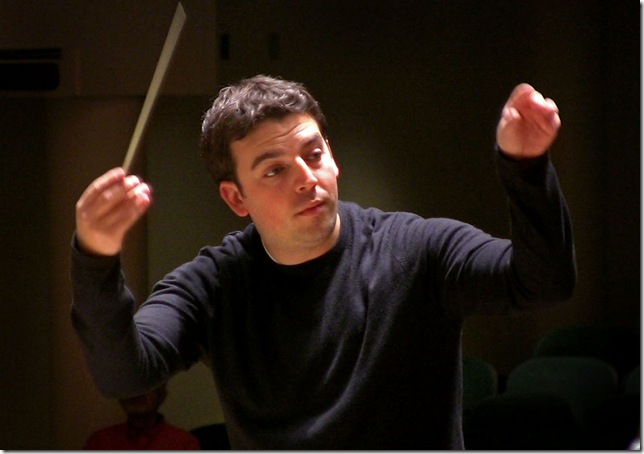Here’s something we can agree on for 2014: It might be time to stop worrying so much about the future of classical music, and of the symphony orchestra.
Two superlative reasons why that is came together Saturday night when the great American violinist Hilary Hahn appeared for the first time with the New World Symphony, in the Knight Concert Hall at Miami’s Adrienne Arsht Center.
Beautifully led by the young American conductor James Gaffigan, the New World gave a marvelous reading of the Prokofiev Fifth Symphony (in B-flat, Op. 100) to close a program that had already reached a high point with Hahn’s appearance as soloist in the Violin Concerto No. 5 (in A, K. 219, Turkish) of Mozart.
You could not watch this exceptional soloist, conductor and ensemble without being reassured about the caliber of players in the upcoming generation of classical musicians (the only caveat being that they all need to find jobs at some point, but we’ll leave that discussion for another time).
Hahn, a Baltimorean whose remarkable career began with an all-Bach solo disc while she was just 16 years old, has gone from strength to strength while almost never following anything like the path usually marked out for leading violin soloists. Although she has committed some of the most-played concerti to disc, her work has been most memorable for her forays into less-familiar repertoire: concertos by Spohr, Paganini and Stravinsky, Schoenberg and Edgar Meyer, and the Bernstein Serenade.
Her most recent discs include the complete violin sonatas of Charles Ives, an all-improvised disc with avant-garde German pianist Hauschka (aka Volker Bertelmann), and a collection of 27 encores Hahn commissioned from some of the world’s most interesting composers. Her performance a couple seasons back of 13 of those encores at a recital in Fort Lauderdale was astonishing for its sheer intellectual honesty and commitment as well as its sheer pleasure as music: Few, if any, classical recitalists would offer their audiences a baker’s dozen of brand-new pieces right in a row, but that evening was a landmark, and a triumph.
Saturday night, Hahn made a terrific Mozart soloist as well, with faultless technique, a crystalline sound, and youthful vigor and wit brought to the task of this marvelous teenage work. From the beginning, Hahn was utterly involved in the music, inclining her head toward the cellos, then the violins, as they accented notes in the opening bars.
Clad in an unusual costume of tan and brown top with a long, dark-blue faux-fur shag skirt, Hahn gave the concerto the sense that she had worked out a series of careful, intelligent choices, including a brief movement of aggressive fiddling in the first movement and a smirky little riff ending to one of the Joseph Joachim cadenzas before the resumption of the main rondo theme in the finale.
She is not a player with a huge, commanding sound, but rather one of supreme classicism, and it served this music well. The opening Allegro aperto sparkled with energy and high spirits, and in her first entrance, an unexpected lyric Adagio, the A major triad she outlined was perfectly in tune, and her intonation remained faultless throughout. The thirds and other harmonies in the cadenza (again, by Joachim) were extra-enjoyable because of this; it allowed the audience to hear the logic of the cadenza without a sense of struggle.
The radiant slow movement was taken at a tempo that moved along rather than stagnated, and never lost its basic pulse, because Hahn and the orchestra made sure to keep the rhythm steady and the note values exact. In so doing, the music flowed naturally, and while the temptation here is to bring a Romantic approach to this movement, keeping it precise and Mozartean gave it an air of high emotion expressed through the most elegant possible discourse.
The usual winter-concert contingent of coughers were out in full force during the second movement, and it had reached a peak before the opening of the finale, so much so that Hahn stopped mid-bow before playing her first note and looked out at the audience with a face that asked: Do you want me to wait? “Get all the coughing out now,” Gaffigan said as he turned around, to laughter and sustained applause. (To be fair, the person coughing the most sounded as though he or she had a serious respiratory problem rather than a Smith Brothers tickle.)
The “Turkish” finale was delightful from beginning to end, and the New World and Gaffigan attacked the janissary music of the middle, with its martial thumping and sliding chromatic scales, with infectious gusto. This Menuetto in rondo form also demonstrated how Hahn works with her colleagues: She makes no effort to play Bigfoot soloist, but weaves in her portion as an indelible part of the whole.
And it was small wonder that she turned around at the end and applauded the orchestra several times; they were superb. The concerto is scored only for strings, two oboes, and two horns, but the orchestral ensemble seemed to lack nothing. The horns in particular were remarkable; there is a lot of high writing for the instruments, but there were no flubbed notes, and indeed, the playing blended beautifully into the fabric of the concerto without sticking out.
Hahn followed the concerto with an encore, the Gigue from the Third Partita (in E, BWV 1006) of J.S. Bach. And here we heard a somewhat different player. In the Mozart, Hahn’s tone was one with the other violinists; alone, she played with a much more commanding sound as she traversed this buoyant music spotlessly. In both cases, her approach to the task at hand was fundamentally right on the money.
The concert opened with a splendid performance of Verdi’s overture to his opera I Vespri Siciliani. Gaffigan, fashionably dressed in all-black, was an engaged, forceful conductor who must have spent a good deal of time getting just the right balances he wanted. The Verdi, which crackled with fire and drama, had all the right dynamic contrasts; in the very end, when the violins are playing their soft, high music (an effect associated most familiarly with the La Traviata overture), the volume dropped to where it should, which showed exemplary control.
It’s the kind of passage that tends to get overlooked in the race to the finish line, but here, every dramatic point Verdi wanted to make in his prelude was present and accounted for.
The second half was devoted to the Prokofiev Fifth, one of the two Prokofiev symphonies (there are seven in all) that gets regular hearings. Gaffigan is recording the complete symphonies with the Netherlands Radio Philharmonic, so this is music that is right at his baton fingers.
Of all the 20th-century Russian composers, Prokofiev had the strongest melodic gift, and the Fifth is full of wonderful tunes that could have been used in many another context than symphony. Additionally, it’s a piece full of striking orchestral color (in few works is the contrabassoon so integral to the sound world, and the same could be said about the percussion battery) and vast dynamic range; in other words, it’s and ideal vehicle for a good orchestra to show off its chops.
And show them off they did. In every way, this was a first-rate performance of this challenging work. In sheer technical fluency, it was remarkable, with standout work including a brass section that played with a balanced sound like liquid gold instead of blasting, crisp, definitive percussion work and clarinet playing in the big tune of the second movement that soared instead of squeaking. The string playing was superb, and one of the greatest attractions of watching the New World is seeing the absolute joy on the faces of young players for whom this music might be new; the cellos in particular seemed to be having a fabulous time.
Gaffigan stressed the various melodic tableaux with exceptional clarity, giving the audience a well-marked road through the symphony. His third movement was especially good because he let the rhythmic ambiguity of its main material speak for itself as it made its rubbery way without trying to make it sentimentally expressive; indeed, it’s that lack of sentiment that is so crucial to Prokofiev’s project, and Gaffigan — who walked into the orchestra afterward to single out sections for applause while personally shaking each of their hands — and the New World brought to this work a powerful realization of the composer’s distinctive style.

